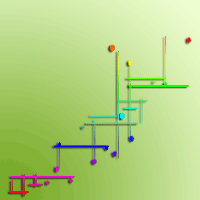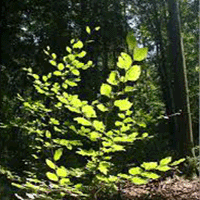
Ensuring future regeneration success of Qualea grandiflora Mart. (Vochysiaceae) in neotropical savanna (cerrado) biomes by reviewing the available information and identifying research gaps
Giovanna Da Ponte , Franka Huth, Sven Wagner
iForest - Biogeosciences and Forestry, Volume 13, Issue 3, Pages 154-164 (2020)
doi: https://doi.org/10.3832/ifor2684-013
Published: May 02, 2020 - Copyright © 2020 SISEF
Review Papers
Abstract
Qualea grandiflora Mart. (Vochysiaceae) is one of the most widespread species within the cerrado formation, which counts amongst the most threatened ecosystems worldwide. Understanding the regeneration ecology of Q. grandiflora is a central requirement for the success of conservation measures and silvicultural management strategies. Exhaustive investigation was carried out into each of the development stages, and the connected processes within the regeneration cycle, to provide a better understanding of the main factors influencing the regeneration ecology and the recruitment dynamics of the species. For this purpose, we analysed 92 different sources of information in this review, divided into two groups (n = 41 with “basic species information” and n = 51 with “specific information about regeneration stages and processes”) relevant for regeneration and silviculture. Our literature review showed the high proportion of studies addressing the processes flowering, pollination and fruiting, whereas the subsequent processes like seed dispersal, seed storage, germination and seedling development are almost entirely lacking. This also applies for spatial information about environmental conditions and the related regeneration processes in Q. grandiflora. This knowledge is important for management, for example, knowledge of the critical distances between flowering and seed producing trees to ensure genetically diverse regeneration and the identification of safe sites for seedling establishment. Most of the practical suggestions in relation to increasing densities or growth of Q. grandiflora seedlings and saplings made in the literature are linked to less intensive fire management strategies adopted at certain times. The use of selective herbivory to reduce the increasing competition pressure exerted by invasive grasses and hampering Q. grandiflora seedlings is also cited. In this study we highlight the need for more complex species-specific information following the development stages and processes of the regeneration cycle so as to prepare a continuous strategy with a range of management approaches.
Keywords
Cerrado Formations, Environmental Influences, Regeneration Cycle, Silvicultural Management Strategies
Authors’ Info
Authors’ address
Franka Huth
Sven Wagner 0000-0003-3796-3444
Institute of Silviculture and Forest Protection, Department of Forest Sciences, Faculty of Environmental Sciences, TU Dresden, P.O. Box 1117, 01735 Tharandt (Germany)
Corresponding author
Paper Info
Citation
Da Ponte G, Huth F, Wagner S (2020). Ensuring future regeneration success of Qualea grandiflora Mart. (Vochysiaceae) in neotropical savanna (cerrado) biomes by reviewing the available information and identifying research gaps. iForest 13: 154-164. - doi: 10.3832/ifor2684-013
Academic Editor
Paola Mairota
Paper history
Received: Nov 14, 2017
Accepted: Feb 12, 2020
First online: May 02, 2020
Publication Date: Jun 30, 2020
Publication Time: 2.67 months
Copyright Information
© SISEF - The Italian Society of Silviculture and Forest Ecology 2020
Open Access
This article is distributed under the terms of the Creative Commons Attribution-Non Commercial 4.0 International (https://creativecommons.org/licenses/by-nc/4.0/), which permits unrestricted use, distribution, and reproduction in any medium, provided you give appropriate credit to the original author(s) and the source, provide a link to the Creative Commons license, and indicate if changes were made.
Web Metrics
Breakdown by View Type
Article Usage
Total Article Views: 41485
(from publication date up to now)
Breakdown by View Type
HTML Page Views: 35468
Abstract Page Views: 2841
PDF Downloads: 2435
Citation/Reference Downloads: 2
XML Downloads: 739
Web Metrics
Days since publication: 2057
Overall contacts: 41485
Avg. contacts per week: 141.17
Citation Metrics
Article Citations
Article citations are based on data periodically collected from the Clarivate Web of Science web site
(last update: Mar 2025)
Total number of cites (since 2020): 3
Average cites per year: 0.50
Publication Metrics
by Dimensions ©
Articles citing this article
List of the papers citing this article based on CrossRef Cited-by.
References
Aspectos da ecologia reprodutiva de tres especies de Qualea (Vochysiaceae) um cerrado de Brasilia, D.F. [Aspects of reproductive ecology of tree species Qualea (Vochysiaceae) in a cerrado ecosystem in Brasilia, D.F.]. MSc thesis, Departamento de Biologia vegetal, Universidade de Brasília, Brazil, pp. 92. [in Portuguese]
Gscholar
Sucesso reprodutivo de Qualea grandiflora Mart. (Vochysiaceae) em um fragmento de cerrado sentido restrito no campus da universidade estadual de Goiás, Anápolis, Brasi. [Reproductive success of Qualea grandiflora Mart. (Vochysiaceae) in a fragment of cerrado (sensu stricto) in the Campus of the State University of Goiás, Anápolis, Brazil]. In: “Anais do IX Seminário de Iniciação Científica, VI Jornada de Pesquisa e Pós-Graduação e Semana Nacional de Ciência e Tecnologia”. Universidade Estadual des Goiás (Brazil) 19-21 Oct 2011, Goiás, Brazil, pp. 1-5. [in Portuguese]
Gscholar
Análise da vegetação arbórea de um remanescente de Cerradão em Bandeirantes, Mato Grosso do Sul, Brasil [Analysis of the arboreal vegetation of a remnant area of a cerradão in Bandeirantes, Mato Grosso do Sul, Brazil]. Iheringia, Séria Botanica, Porto Alegre 66: 31-46. [in Portuguese]
Gscholar
Estabelecimento de Qualea grandiflora Mart. e Kielemeyera coriacea Mart. e seu comportamento sazonal em duas fitofisionomias típicas dos cerrados do Brasil central [Establishment of Qualea grandiflora Mart. and Kielemeyera coriacea Mart. and their seasonal behavior in two typical vegetation types of cerrado ecosystems central Brazil]. In: “Anais do VIII Congresso de Ecologia do Brasil”, Caxambu (MG, Brazil), 23-28 Sept 2007, pp. 1-2. [in Portuguese]
Gscholar
Regeneration ecology of anemochorous tree species Qualea grandiflora (Mart.) and Aspidosperma tomentosum (Mart.) of the cerrado Aguara Ñu located in the Mbaracayú Nature Forest Reserve (MNFR), Paraguay. PhD thesis, Institute of Silviculture and Forest Protection, University of Technology Dresden, Germany, pp. 176.
Gscholar
Efeito de Queimadas sobre a estrutura e composição da comunidade vegetal lenhosa do cerrado sentido restrito em Caldas Novas, GO [Burning effect on structure and composition of the woody plant community of cerrado (sensu stricto) in Caldas Novas Goiás]. Revista Árvore, Viçosa-MG 33: 695-704. [in Portuguese]
CrossRef | Gscholar
Caracterização de dois estratos da vegetação em uma área de cerrado no município de Brotas, SP, Brasil [Characterisation of two vegetation layers in a cerrado area in Brotas municipality, São Paulo, Brazil]. Acta Botanica Brasilica 16: 251-262. [in Portuguese]
CrossRef | Gscholar
Morfologia de sementes e plntulas de pau-terra (Qualea grandiflora Mart. - Vochysiaceae) [Morphology of seeds and seedlings of pau terra (Qualea grandiflora Mart. - Vochysiaceae)]. Revista Brasileira de Sementes 23: 116-122. [in Portuguese]
CrossRef | Gscholar
Aspects of the soil-water-plant relationships in conexion with some Brazilian types of vegetation. In: “Tropical Soils and Vegetation: Proceedings of the Abidjan Symposium”. Abidjan (Côte d’Ivoire) 20-24 Oct 1959. Commission for Technical Cooperation in Africa South of Sahara, UNESCO, Paris, France, pp. 103-109.
Online | Gscholar
Qualea cordata, pollination by the territorial bee Centris tarsata in the “campos rupestres”, Brazil. Ciência e Cultura, Journal of the Brazilian Association for the Advancement of Science 45 (2): 144-147.
Gscholar
Eugen Warming e o cerrado brasileiro: um século depois [Eugen Warming and the Brazilian cerrado: a century later]. Editora UNESP, Imprensa Oficial do Estado, Sao Pãulo, Brazil, pp. 156. [in Portuguese]
Gscholar
Fenologia e caracterização de frutos e sementes de um cerrado sensu stricto, Jardim Botnico de Brasília, Distrito Federal, Brasil, com ênfase nas espécies com síndrome ornitocórica [Phenology and characterization of fruits and seeds in a cerrado (sensu stricto), Botanical Garden of Brasília, Federal District, Brazil, with emphasis on bird dispersed species]. M.Sc. thesis, Departamento de Botnica, Universidade de Brasília, Brasília, Brazil, pp. 88. [in Portuguese]
Gscholar
Síndromes de dispersão e fenologia reprodutiva de 50 espécies amplamente distribuídas no Cerrado sentido restrito [Dispersal syndromes and reproductive phenology of 50 species widely distributed in the cerrado (sensu stricto)]. Universidade de Brasília, Instituto de Biologia, Brasília, Brazil, pp. 92. [in Portuguese]
Gscholar
Management of cerrado trees using growth rings. Australian Journal of Basic and Applied Sciences 10 (16): 92-103.
Gscholar
Comportamento fenológico de espécies lenhosas em um cerrado sentido restrito de Brasília, DF [Phenological behavior of woody species in a cerrado (sensu stricto) in Brasília, DF]. Revista Brasileira de Botnica 29: 627-638. [in Portuguese]
Gscholar
Distribuição espacial de espécies arbóreas em fragmentos de Cerrado sentido restrito no planalto central Brasileiro-GO [Spatial distribution of woody species in a cerrado (sensu stricto) plateau fragments of central Brazil, Goiás]. Biociências 15: 160-165. [in Portuguese]
Gscholar
Árvores brasileiras: manual de identificação e cultivo de plantas arbóreas nativas do Brasil. [Brazilian trees: identification manual and cultivation of native arboreal plants of Brazil] Editora Plantarum Nova Odessa, São Paulo, Brazil, pp. 368. [in Portuguese]
Gscholar
Síndromes de dispersão de espécies arbustivo-arbóreas em diferentes fitofisionomias no norte de Minas Gerais [Dispersal syndromes of shrub-tree species in different vegetation types in north of Minas Gerais]. In: “IX Simpósio Nacional Cerrado e II Simpósio Internacional Savanas Tropicais”. Embrapa, Planaltina, Brazil, pp. 1132. [in Portuguese].
Gscholar
O serviço de polinizadores e a eficácia reprodutiva das plantas do cerrado de Anápolis [Service of pollinators and the reproduction efficacy of plants of cerrado of Anápolis]. State University of Goiás, Brazil, pp. 1-6. [in Portuguese]
Gscholar
Biomass allocation and growth of tree seedlings from two contrasting Brazilian savannas. Ecotropicos 13: 43-51.
Gscholar
Silviculture: concepts and applications (2nd edn). McGraw-Hill, Boston, MS, USA, pp. 682.
Gscholar
Anemocoria em espécies de Cerrado e mata de galeria de Brasília, DF [Anemochory in cerrado and gallery forests species of Brasília, DF]. Revista Brasileira de Botnica 15: 163-174. [in Portuguese]
Gscholar
The cerrados of Brazil: ecology and natural history of a neotropical savanna. Columbia University Press, New York, USA, pp. 398.
Gscholar
Qualea grandiflora Mart.: crescimento inicial e crescimento foliar em árvores [Qualea grandiflora Mart.: initial growth and leaf growth in trees]. PhD thesis, Universidade de Campinas, Brazil, pp. 199. [in Portuguese]
Gscholar
Root/ shoot partitioning and water relations in Qualea grandiflora (Vochysiaceae) seedlings under water stress. Revista de Biologia Tropical 46: 41-44.
Gscholar
“Cerrado” restoration by direct seeding: field establishment and initial growth of 75 trees, shrubs and grass species. Brazilian Journal of Botany 40 (3): 681-693.
CrossRef | Gscholar
Fenologia de uma comunidade arbórea em Cerrado sentido restrito, Barra do Garças, MT, Brasil [Phenology of a woody community of a cerrado (sensu stricto), Barra do Garças, Mato Grosso, Brazil]. Acta Botanica Brasilica 23: 1096-1109. [in Portuguese]
CrossRef | Gscholar
Avaliação da distribuição de espécies arbóreas em um fragmento de cerrado do município de Itirapina. [Analysis of the distribution of woody species in a cerrado fragment of Itirapina municipality]. Department of Botany, State University of Campinas, São Paulo, Brazil, pp. 13. [in Portuguese]
Gscholar
Seed dynamics and seedling establishment of woody species in the tropical savannas of central Brazil (Cerrado). PhD thesis, Department of Biology, University of Miami, FL, USA, pp. 180.
Gscholar
Estudo fenológico de Davilla elliptica St. Hill. e Qualea grandiflora Mart. em uma área de Cerrado sentido restrito em Porto Nacional, Tocantins [Study of phenology of Davilla elliptica St. Hill. and Qualea grandiflora Mart. in a cerrado (sensu stricto) area in Porto Nacional, Tocantins]. Revista Interface (Porto Nacional) 5: 3-14. [in Portuguese]
Gscholar
A hectare of cerrado. II. Flowering and fruiting of thick-stemmed woody species. Phyton 41: 129-158.
Gscholar
Twenty years of post-fire plant succession in a “cerrado”, São Carlos, SP. Brazilian Journal of Biology 66 (2b): 587-602.
Gscholar

















